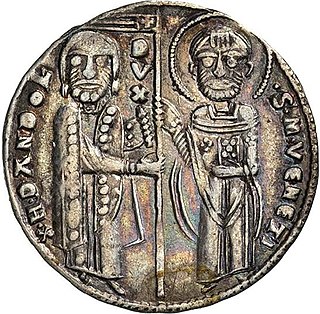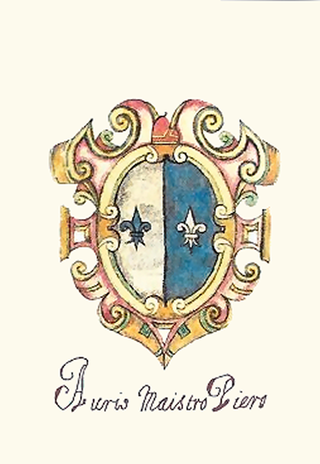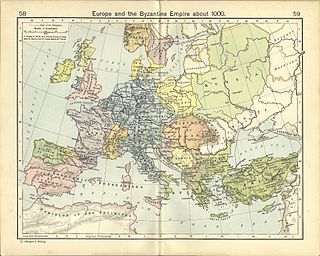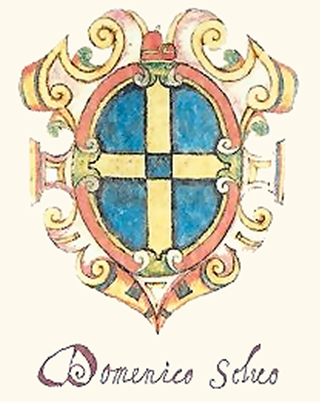
The Doge of Venice, sometimes translated as Duke, was the chief magistrate and leader of the Republic of Venice between 726 and 1797.

Enrico Dandolo was the Doge of Venice from 1192 until his death. He is remembered for his avowed piety, longevity, and shrewdness, and is known for his role in the Fourth Crusade and the Sack of Constantinople. Dandolo died in 1205 in Constantinople and was buried at the Hagia Sophia.

Sebastiano Ziani was Doge of Venice from 1172 to 1178. He was one of the greatest planners of Venice.

Orio Mastropiero, forename sometimes rendered as Aurio and surname as Malipiero, was a Venetian statesman who served as the doge of Venice from 1178 to 1192. He was elected by the Council of Forty in 1178 following the retirement of Sebastiano Ziani. Prior to this he had been an ambassador to Sicily in 1175, tasked with drawing up a treaty with King William II. He had also been the electors' first choice for Doge following the death of Vitale II Michiel in 1172, but stepped aside in favour of Sebastiano Ziani, an older and wealthier man.
Marco Sanudo was the creator and first Duke of the Duchy of the Archipelago, after the Fourth Crusade.

The House of Orseolo was a powerful Venetian noble family descended from Orso Ipato and his son Teodato Ipato, the first Doges of Venice. Four members of the Orseolo family became Doges, Commander of the Venetian fleet, and King of Hungary. They reconstructed St Mark's Basilica and the Doge's Palace after the revolution.

Krešimir III was King of Croatia from 1000 until his death in 1030. He was from the Trpimirović dynasty and founder of the Krešimirović branch of the family. He was the middle son of former King Stjepan Držislav. Until 1020, he co-ruled with his brother Gojslav.

The Treaty or Peace of Venice, 1177, was a peace treaty between the papacy and its allies, the north Italian city-states of the Lombard League, and Frederick I, Holy Roman Emperor. The Norman Kingdom of Sicily also took part in negotiations and the treaty thereby determined the political course of all Italy for the next several years.
Giustiniano Participazio was the eleventh (traditional) or ninth (historical) Doge of Venice from 825 to his death. His four years on the ducal throne were very eventful. He was made hypatus by the Byzantine emperor Leo V the Armenian.

Domenico Selvo was the 31st Doge of Venice, serving from 1071 to 1084. During his reign as Doge, his domestic policies, the alliances that he forged, and the battles that the Venetian military won and lost laid the foundations for much of the subsequent foreign and domestic policy of the Republic of Venice. He avoided confrontations with the Byzantine Empire, the Holy Roman Empire, and the Roman Catholic Church at a time in European history when conflict threatened to upset the balance of power. At the same time, he forged new agreements with the major nations that would set up a long period of prosperity for the Republic of Venice. Through his military alliance with the Byzantine Empire, Emperor Alexios I Komnenos awarded Venice economic favors with the declaration of a golden bull that would allow for the development of the republic's international trade over the next few centuries.

Otto Orseolo was the Doge of Venice from 1008 to 1026. He was the third son of Pietro II Orseolo and Maria Candiano, whom he succeeded at the age of sixteen, becoming the youngest doge in Venetian history.

Jacopo Tiepolo, also known as Giacomo Tiepolo, was Doge of Venice from 1229 to 1249. He had previously served as the first Venetian Duke of Crete, and two terms as Podestà of Constantinople, twice as governor of Treviso, and three times as ambassador to the Holy See.

Vitale II Michiel was Doge of Venice from 1156 to 1172.

The Nicaean–Venetian Treaty of 1219 was a trade and non-aggression defense pact signed between the Empire of Nicaea and the Republic of Venice, in the form of an imperial chrysobull issued by Emperor Theodore I Laskaris. This treaty provided the Venetians freedom of trade and imports without customs duties throughout the Empire, in exchange for not supporting for the newly created Latin Empire.
This article presents a detailed timeline of the history of the Republic of Venice from its legendary foundation to its collapse under the efforts of Napoleon.
Constance of Sicily was a Sicilian Princess and the Dogaressa of Venice by marriage to the Doge Pietro Ziani.
The promissione ducale was an oath of office sworn by the incoming Doge of Venice. It contained not only an oath of allegiance to the Republic of Venice, but also spelled out the constitutional limitations to the Doge's power, which he swore to abide by.

In 1268, the Byzantine Empire and the Republic of Venice agreed to temporarily end hostilities which had erupted after the Byzantine recovery of Constantinople by Emperor Michael VIII Palaiologos in 1261.
The Podestà of Constantinople was the official in charge of Venetian possessions in the Latin Empire and the Venetian quarter of Constantinople during the 13th century. Nominally a vassal to the Latin Emperor, the Podestà functioned as a ruler in his own right, and answered to the Doge of Venice. The podestà was also officially known as Governor of One-Fourth and One-Half of the Empire of Romania and was entitled to wearing the crimson buskins as the emperors.
Marco Badoer da Santa Giustina was a Venetian administrator, diplomat and military commander.













